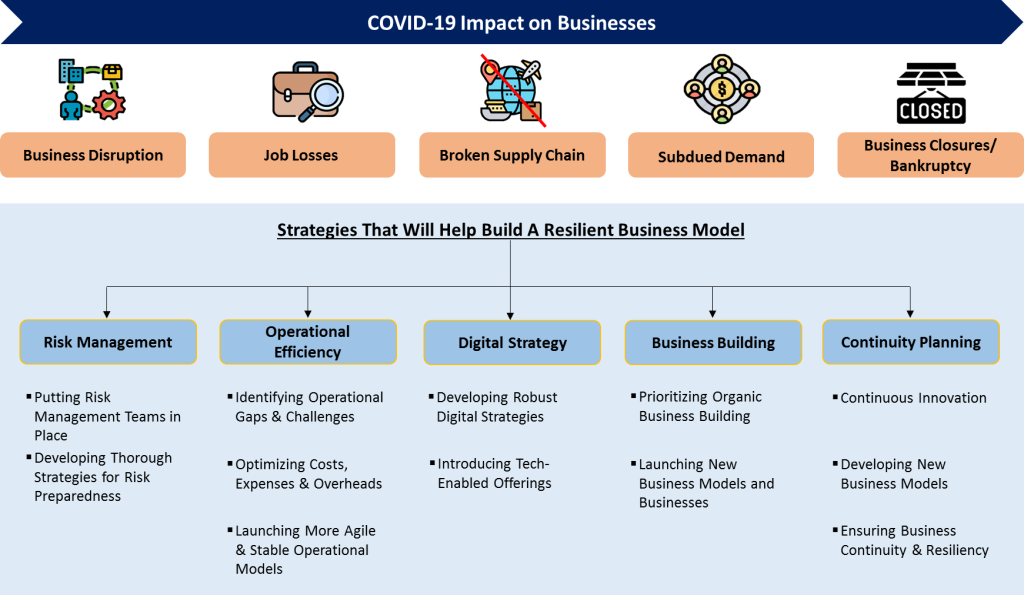COVID-19 has inflicted profound and arguably lasting scars, pushing economies into largely unfamiliar and unchartered territory, as businesses crashed across the world and livelihoods were threatened.
Economic growth already saw a setback post the 2008 financial crunch, and the pandemic merely actualized underlying concerns regarding the lack of global preparedness to handle another major disruption. This crisis exposed businesses to a barrage of challenges, forcing them to navigate disrupted supply chains and rapidly-plunging consumer demand, in addition to an acceleration in existing risks such as protectionist measures limiting capital flows across geographies and deteriorating international trade relationships. The result was record unemployment highs across the world, reaching as much as 14.7% in the US in April to abruptly end a decade of expansion. Notably though, the global response was quick and unanimous, with governments rolling out several expansionary policies, pumping billions of dollars in stimulus packages to support their economies, slashing interest rates to new lows to encourage borrowing and spending, and increasing public expenditure (fiscal spending as a % of GDP grew by ~20% YoY in ~22 nations). Moreover, sizeable economic buffers, subsidies and initiatives were launched to protect small businesses and individuals from the aftermath of the crisis.
While these measures may have minimized the scale of economic destruction, businesses still had to make a number of crucial decisions for survival and growth during the period. However, the speed and efficacy with which companies managed a successful pivot, has been largely driven by the willingness and ability of their leaders to make tough choices, and exhibit agility and stability as they quickly adapt to the new reality. Amid slowed and/or negative economic growth, the importance of catalyzing headwinds and turning them into opportunities for growth and expansion was highlighted. As a result, businesses were forced to develop enhanced business strategies and adopt fresh growth models that are acclimatized to the current and post-COVID environment.
The pandemic clearly ushered in an era of change for doing business around the globe. Corporates familiarized themselves with a host of new strategic considerations; right from making survival decisions, transitioning from survival to growth, and eventually planning the shift to an optimized state post the pandemic. Critical decisions were made to account for high-impact and low-likelihood risks like COVID-19, to prioritize organic business building, ensure business continuity and resiliency, and welcome new operational models that are poised to thrive in a digitally disruptive era. Adopting disruptive innovation also emerged a massive game-changer, as witnessed by opportunistic companies who gained substantial market advantage over peers by moving out of their comfort zones to expand their offerings with innovative business models, products, and services to suit the current climate. The growing prominence of connectivity and digitalization led growth in several technology-enabled sectors including 5G, cloud computing, AI & big data analytics, IT, and video gaming and online streaming, as well as across HealthTech, Fintech, EdTech, and e-Commerce platforms among others. 2020 has a number of success stories to this accord, of which one of the largest is probably the cloud computing offering by Amazon – Amazon Web Services (AWS) – which witnessed accelerated traction, enabling it to claim ~30% of the global cloud-computing market.
In similar fashion, a plethora of businesses are maneuvering uncertainty through digitization, optimizing cost structures and operational models, and appropriately managing their risk and financial liquidity positions. In fact, a McKinsey survey revealed two things – that companies are growing faster by prioritizing business building for organic growth and launching new businesses at an accelerated rate; and that the sturdiest companies are reinventing themselves through next-normal operating models, capitalizing on this pliable phase and the resulting spread of agiler processes, and higher speed and productivity. Several companies have mobilized their response via crisis management plans to aid a smooth transition and course-correct whenever needed. Companies are also assessing the ripple impact of the pandemic’s disruption to identify alternate routes for sourcing, production, and distribution of products and services on a wider scale, while simultaneously restructuring cost configurations so as to optimize operational efficiency. Meanwhile, digital strategies have been rewritten by organizations who are expanding to launch new tech-enabled offerings. For instance, the rally to provide cloud-based contactless order, pick-up and delivery services within the retail and F&B sectors, has allowed them to explore fresh avenues through a massive new online user market segment.
However, the primary consideration for business survival ultimately boils down to their ability to generate positive cash flows and consistently grow revenues. At a time of crisis, assessing the strength of their balance sheets and testing scenarios to ascertain best-case and worse-case situations, is likely to continue enabling companies to successfully achieve optimal cash and liquidity positions, and help them emerge stronger. In 2020, as the importance of cash-conservation has been further stressed, identifying ways to generate and preserve cash could also potentially improve access to banks and equity fundraising to propel growth.

As 2020 draws to a close, it now becomes important for businesses to formulate forward-looking strategies for growth. While uncertainty has prevailed for much of the current year, global economies have already begun to show green shoots of recovery, evidenced by improvements in manufacturing activity, surging consumer demand, and Q3 GDP reversing track to bounce back to growth in many economies. Moreover, medical clarity around COVID-19 has considerably improved, and the recent authorization of vaccines for public dissemination has ushered fresh optimism for 2021. However, a cohort of concerns could instigate a continued reign on uncertainty, including the new mutated virus strains; logistical challenges, as well as concerns over vaccine safety and effectiveness. Moreover, businesses must factor in the implications of other critical macroeconomic factors and externalities that could potentially impact operations and profitability.
With 2020 playing out as it did, it would be novice to expect a return to business normalcy as in pre-pandemic times. Thus, businesses must strategize for the coming year keeping a strict focus on the aforementioned factors, in careful consideration alongside the company’s fundamentals and organic growth-generating ability. It is essential that business leaders and executives prepare to combat future uncertainty by diligently assessing the full potential of their business, interdependencies, and the implications of exploring all-out diversification. They must also structure a program that creates maximum value both for the business and customers. Keeping a contingency plan in place will further enable businesses to continuously reassess their fundamentals against the constantly evolving external environment and adjust their financial assumptions and scenarios accordingly, which will in turn aid them in preparing to respond better in the face of adversity.
As the crisis shapes over the course of 2021, businesses must factor in that they could restrict or accelerate the momentum of economic recovery in the long run. In a world of slowing growth, businesses will definitely be challenged but this is also likely to result in a greater degree of innovation, as technologies take on a greater role in business for the early adopters to emerge as clear market winners. New trends that have enabled the birth and growth of colossal new industries such as 5G, cloud computing and more, are ushering in limitless new possibilities for companies that can manage to successfully jump on to the bandwagon.
On the other hand, companies whose business plan revolves around pre-pandemic operational models are in most likeliness adopting a losing strategy and could potentially miss out on exponential returns. It is thus worth reiterating the criticality for businesses to understand how to modify their strategies, adapt to ongoing trends, and drive growth and expansion, not just in the short term, but sustainably for years to come.

Comments
Mempreame
2 years agoufejoko
3 years agoahiitata
3 years agoohayyfact
3 years agoonezirinigem
3 years agoajopimixazuh
3 years ago